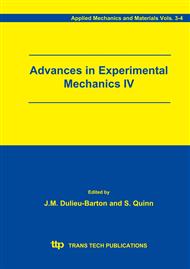p.71
p.79
p.85
p.91
p.99
p.105
p.111
p.117
p.125
Ultrasonic Compression Tests on Aluminium
Abstract:
A study is presented into the effect of ultrasonic activation of the platen on the stressstrain relationship in compression tests on aluminium specimens. The aim is to gain some insights into the reported beneficial effects of ultrasonically excited tools in metal forming operations. The paper investigates the compression of aluminium specimens using a variety of different lubricants under conditions of constant crosshead velocity and superimposed longitudinal ultrasonic excitation of the platen. The study shows that the changes in the stress-strain relationship under ultrasonic excitation can be explained in terms of the superimposed oscillatory stress condition and that there is some evidence of small changes in the interfacial friction condition.
Info:
Periodical:
Pages:
99-104
Citation:
Online since:
August 2006
Authors:
Keywords:
Price:
Сopyright:
© 2005 Trans Tech Publications Ltd. All Rights Reserved
Share:
Citation:


